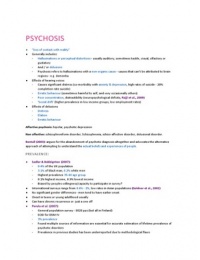“loss of contact with reality”
Generally includes:
- Hallucinations or perceptual distortions - usually auditory, sometimes tactile, visual, olfactory or
gustatory
- And / or delusions
- Psychosis refers to hallucinations with a non-organic cause - causes that can’t be attributed to brain
regions - e.g. dementia
Effects of hearing voices
- Causes significant distress (co-morbidity with anxiety & depression, high rates of suicide - 20%
completion rate suicide)
- Erratic behaviour (sometimes harmful to self, and very occasionally others)
- Poor concentration, distractibility (neuropsychological deficits, Rajji et al., 2009)
- ‘Social drift’ (higher prevalence in low income groups, low employment rates)
Effects of delusions
- Distress
- Elation
- Erratic behaviour
Affective psychosis: bipolar, psychotic depression
Non affective: schizophreniform disorder, Schizophrenia, schizo-affective disorder, delusional disorder.
Bentall (2003): argues for the abandonment of psychotic diagnosis altogether and advocates the alternative
approach of attempting to understand the actual beliefs and experiences of people.
PREVALENCE:
Sadler & Bebbignton (2007):
- 0.4% of the UK population
- 3.1% of black man, 0.2% white men
- Highest prevalence 35-44 age group
- 0.1% highest income, 0.9% lowest income
- Biased by peoples willingness/capacity to participate in survey?
International surveys range from 0.4% - 2%, low rates in Asian populations (Goldner et al., 2002)
No significant gender differences - men tend to have earlier onset
Onset in teens or young adulthood usually
Can have chronic recurrence or just a one off
Perula et al. (2007):
- General population survey - 8028 pps (but all in Finland)
- SCID for DSM-IV
- 3% prevalence
- Found multiple sources of information are essential for accurate estimation of lifetime prevalence of
psychotic disorders
- Prevalence in previous studies has been underreported due to methodological flaws
, Significant heterogeneity of prevalence and incidence rates - so clinicians and policy makers need to look
at local data (Goldner et al., 2002) or could be down to methodological differences in studies
Who experiences psychosis?
- Range of several psychiatric conditions, mainly SZ or bipolar, but also severe depression and some
personality disorders
- Van Os (2000)– Netherlands household survey found 17% people report psychotic phenomena, but
small proportion able to be diagnosed with a psychotic disorder.
- Is psychosis on a continuum?
KEY DEBATES:
1. Is psychosis best considered within a categorical ‘disease’ model, or as a continuum?
- People have thoughts which don’t quite feel part of them but aren’t voices, maybe further down the
continuum they would be voices
- If it’s a continuum can study normal population, if a disease can only study patients
- John & van Os (2001) 25% reported having transient delusions/hallucinations but only 3.6% met
criteria for schizophreniform illness
- Garety (2007) in a review article said the evidence supported psychosis on a continuum
- Van Os (2000) random sample of 7076b people interviewed, 17.5% of people had any type of positive
psychosis rating, only 2% had DSM-III diagnosis.
- Strauss (1969) said continuity of psychotic phenomena in clinical settings
- Van Os (2000) showed also on a continuum in the general population.
2. Can we integrate into a single theory the social, psychological and biological factors that are
implicated in the causation of psychosis?
- Side effects can be horrendous - given bad biological explanations to make them take them, we need
to integrate theories and not have them competing.
3. Untangling cause and effect in chronic illness.
- Need to study people who have not been on many drugs - large ventricles could be caused by the
illness or by medication?
THEORIES
SOCIAL (PLACE AND ETHNICITY)
Concentration of psychosis in:
- Urban groups
- The UK afro-Caribbean community
st
- 1 generation immigrants to the UK
Increases as unemployment increases
Social selection (downward drift)
Sociogenic hypothesis (more life stressors)
Social labelling (development and maintenance of symptoms are influenced by diagnosis)


